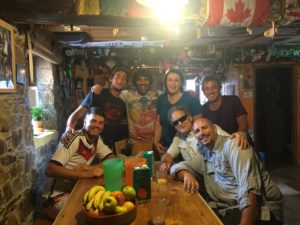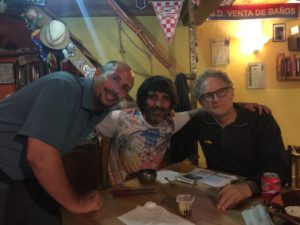the del Norte/Primitivo route.
Spain: From Irun to Santiago de Compostela, 530 miles.
Post 40; July 10, 2016, Sunday.
Day 26: San Juan De Villapañada to Bodenaya. On The Camino Primitivo.
It will be the last place they look: for happiness.
How a seed gets planted.
Carlos and I left the San Juan de Villapañada Albergue de Peregrinos at about 6:30 a.m. Final analysis: it’s an okay albergue run by Domingo Ugarte, who had a hard job last night as all the pilgrims kept coming in and coming in. Finally, he just had to turn the late coming pilgrims away. I don’t know where they went or how. (Just one more reason the Primitivo is so hard.) More pilgrims are now on the Camino as we get closer to Santiago. As I said yesterday, three pilgrims, Carlos, Angelus, and Ted, slept on the floor in the kitchen. The room I was in was packed with pilgrims, maybe 25 of us, bunk beds as usual. Noisy as usual. Lots of noises you never hear until so many people are packed together in one room. I already spoke about those pilgrims that just started yesterday. So, those of us that have already trekked about 350 miles have to fight off snootiness, or something like that. We feel a combination of really strong and fit, seasoned, and a little damaged, sore, and beaten up.
Vaiva is here now, next to me, she’s an actress from Lithuania. We walked together for quite awhile. And now we sit here, quiet, writing. Vaiva is magical, she writes poems, she looks like Grace Kelly, and she orders me around with a vivaciousness that is the source of her name. And she says . . . she is happy. You know, on the Camino, people say exactly how they feel. And, happiness is quite prevalent. And yet what we are doing is—hard.
And so I should mention that Carlos, Willie, Leo, and I, with Vaiva trekked together in various combinations all day, a great all day. For the record this is Stage 4 of the Camino Primitivo: San Juan de Villapañada to Bodenaya. We trekked through the little Spanish towns of: Santa Eulalia de Dóriga, Cornellana, and Salas (that has a great church already in action because it’s Sunday, and a castle), and then we did it, . . . we made it to: BODENAYA. Oh my, this is what the Camino is truly all about. The camaraderie, the friends, the celebration, the pilgrims’ dinner, the joy, and sitting here next to Vaiva, who now corrects me and so, here’s the correct spelling: Vaiva Kvedaraviciute. Wow, you should hear her pronounce it! Anyway, this is the Camino, this is why we made it all the way here to this little place: Bodenaya. David is the Hospitelero at this albergue. He owns it and tells us the long story of how he came to own it by buying it from his old friend Alex who fell in love with a pilgrim, got married, had a baby . . . and lives a happy life, but with new responsibilities. David is not married; his heart was broken once and he’s yet to fully recover. But, he’s happy, and content with all his Camino families. And he tells us a tale from India and I type as he talks, and I drink wine, and Vaiva listens, and someone plays guitar in the background, mostly Italian lyrics, sounds like Bocelli, really. . . .
A tale from David:
All the gods had gotten together and were happy that they had created humans, and they decided that it was time to create, “happiness.” They decided that they had to make happiness something that humans had to work for. So one god says, let’s put happiness at the top of the highest mountain so that humans must climb the mountain to find happiness. And they were pleased with this idea. But one god expressed his concern, saying that humans will eventually build devices that can easily fly to the top of the mountain, or machines that will transport them to the top of the mountain, and then, it will just be too easy to obtain happiness, and happiness will not be appreciated. They all agreed, let’s not put happiness at the top of a mountain. Then another god said, let’s put happiness way down a dark dark cave that will be very hard to find and get to. They talked about it, and agreed that may work, and they liked the idea. But again, one god expressed his concern that, there again, humans will just build machines, and light systems and they will be able to find happiness way down a cave, and it will be too easy and they won’t appreciate happiness. And finally, one god, who had been quietly sitting in the corner said, it’s very simple, let’s hide happiness inside each human, because it will be the last place they look, and they won’t be able to create some machine that will make its discovery easy, but, if . . . they ever find happiness there, inside them, . . . they will truly be happy, and, . . . appreciate happiness. And they all agreed.
And happiness was created.
And so, the pilgrims’ dinner is ready and we all sit down and eat a great pasta dinner, then a great soup dish, bread, wine, and more. I sit next to David, Carlos and Vaiva. There are about 14 people at our table. It’s perfect. All is good. No pain right now. And so it goes, as I ask David for the title of one of his favorite books and he brings down from a shelf close to him: Happiness, Happiness Born Inside Yourself, by Osho. The title is Spanish, so I think I got the translation right.
And, so that’s the theme tonight: happiness.
And David tells us more about the life he left behind of a successful career in a factory, but as time went on and he did more Caminos, it was hard to return to work because . . . all the people on the Camino are “good,” but back in the life where he worked, people are not so good, and it became too hard for him. He said it again: all people on the Camino are good.
And so is it at Bodenaya, and it’s 10:30 p.m. and if you don’t go to bed now, it will be very hard to get up at 6:36 a.m. Yes, the “family” for the evening at this albergue, at David’s prompting decide, as a family, what time to get up in the morning. And the family decided on 6:36 a.m. for all these fun symbolic reasons. Okay.
. . .
Apple watch tally:
Calories burned: 1278
Total steps for the day: 32,631
Miles: 17.41
p.s. So, this is how it happens. How a seed gets planted. We were all up the next day at 6:36 a.m. and had a pilgrims’ breakfast and all was well as we planned the day. Carlos and I were among the last to leave. We were talking to the hospitelero, David, and he was so excited about his adventure coming toward the end of the year with a friend. He was going to do the Camino de Assisi, The Way of St. Francis. Wow, was he excited about it! Time was pressing as the pilgrims were leaving the Bodenaya albergue, but David told Carlos and me about the Camino de Assisi and he explained mostly the route from Florence to Assisi and then on to Rome and how it worked . . . and yet he knew we still had a long trek for the day to Campiello. David showed us his Pilgrims Credencial for the Camino de Assisi and then he looks at us and says: “you should do it sometime.”
And I say, “I will.”
And, as one who has always had a strong sense of when a seed is planted in his life, . . . I say to those who for the next year ask me where I got the idea to do The Way of St. Francis, read Post 40 from July 10, 2016. I’ll be hitting the Camino de Assisi on Monday, June 12, 2017 . . . at about 6:30 a.m. Give or take.
Amen.
. . .

Pilgrims at the Bodenaya Albergue
